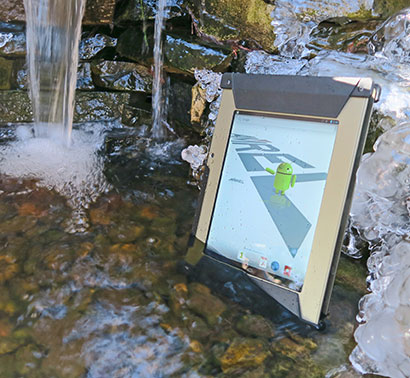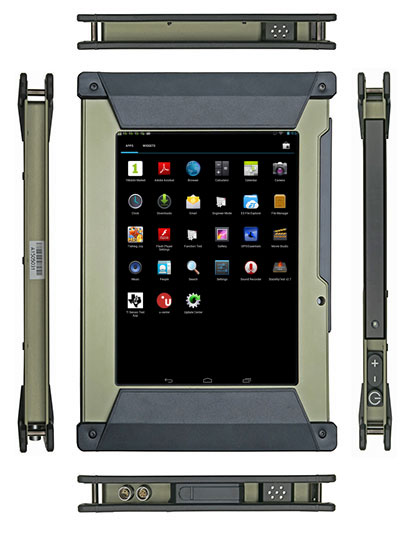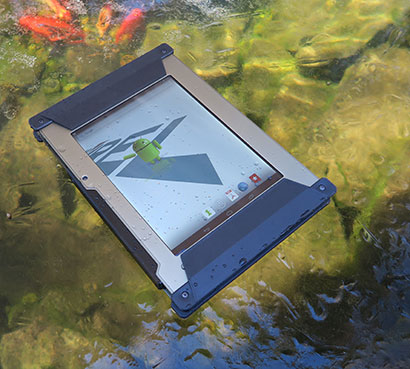|
AMREL Flexpedient AT80
Your company, too, can be a virtual rugged tablet manufacturer with this eminently sensible, customizable, personalizable 8-inch Android device
(by Conrad H. Blickenstorfer)
Based in El Monte, California, AMREL has a long history of offering value-added hardware and applications in vertical markets. The Rocky line of ruggedized computers was introduced in 1995 and has been updated, enhanced, complemented and fine-tuned every since. This page covers the company's very different 8-inch Flexpedient AT80 rugged Android tablet computer.

Why very different? Because the AT80 was built from the ground up as a "channel design," i.e. a product that AMREL can very quickly equip, configure, and even brand to customer specifications.
Does that mean it's like going on Dell's or Apple's online store and click all the options you want? Yes, but it goes beyond that. Customers — and we're really talking enterprise and government customers here — aren't limited to just picking a few options; they can specify very detailed configuration requests, whatever they may be, and then select from no fewer than ten different colors and add their own logo and brand to the tablet. AT80 customers, in other words, become virtual manufacturers.
There are some limitations, of course. For example, the AT80 so happens to be an Android-based rugged tablet with an 8-inch display. Beyond that, it's all up to the customer. It all starts with the frame shown below. It's machined from a single aircraft aluminum billet. The frame is then sandwiched between an aluminum top plate and an aluminum bottom plate, both with protective rubber grips.

The evaluation unit AMREL sent us was sealed, and so we can't show you what, exactly, is inside. What we do know is that it's a Texas Instruments OMAP 4470-powered motherboard with a wide area of mechanical attachment points. The basic default AT80 configuration looks like this:

It's quite obvious that AMREL designed the AT80 not as a full, cast-in-stone product, but more like a tool that can easily be configured for the job at hand. There is, for example, no dedicated I/O block. That's because I/O can be anywhere along the frame's four sides. As is, the basic AT80 comes with just USB OTG and an audio jack. Serial, Ethernet and USB 2.0 host are available as off-the-shelf options. But that's just the beginning. Customers can also specify a biometric sensor, a CAC reader, specialized connectors, and just about any integrated device. Whatever it takes to get a particular job done.
All of this makes this AMREL tablet far more than just a tablet with a bunch of options. For customers, it's more like specifying their very own tablet, either for their own use, for resale, or for packaging with specialized software. AMREL will charge a modest NRE (non-recurring engineering) fee for customization beyond the standard options, but that's much less than what it costs to create a product from scratch. AMREL emphasizes that most custom modifications require minimal NRE and can be made within weeks or less.
Thin, sensible, light, and tough
After all is said and done, despite its unique design, the AT80 is still an AMREL tablet, which means it's uncompromisingly rugged. The tablet carries IP67 sealing, where the "6" means it's totally dustproof, and the "7" that it's also waterproof and can even be immersed in water down to about three feet, for a whole hour. The AT80 can survive 4-foot drops, and has been tested for vibration resistance. The operating temperature range is a very wide -4 to 140 degrees Fahrenheit, enough for virtually any deployment.
Despite its superior toughness, the AT80 is less than an inch thick and weighs just 1.65 pounds. The tablet's 9.4 x 6.9 inch footprint is almost exactly that of the standard Apple iPad. Due to its extensive protection, the AT80's display measures 8.0 inches diagonally compared to the iPad's 9.7 inches. The display offers 1024 x 768 pixel resolution, which makes for a 4:3 aspect ratio and 160 dots per inch resolution. That means it's considerably sharper than the original iPad. The display uses the popular projected capacitive multi-touch, as one would expect today. Luminance of the direct-bonded display is in the 350 nits range. That's more than most laptops, but a bit less than the iPad Air 2. Viewing angles are perfect from any side.
Despite its mission to be an almost infinitely configurable tool for almost any imaginable job, the AT80 includes the features everyone expects today, like dual cameras (that are quite good), and a full complement of sensors.
The AT80 comes with Android 4.3 "Jelly Bean." As of January 2016, that's still a widely used version. We don't know if AMREL will offer upgrades to the newer KitKat or Lollipop versions.
A convincing platform and attractive opportunity
When the AMREL AT80 first came into our lab, we didn't quite know what to make of it. It was just so different from AMREL's (or anyone else's) rugged tablets. But the more we examined it and used it, the more we liked it. If the AT80 were a vehicle, it'd be a Jeep. Basic, tough, sensible, indestructible. But whereas Jeeps have always been bare-bones and not terribly refined, the AT80 feels very high-tech despite its basic construction, and it operates as smoothly and responsively as any consumer smartphone or tablet.
The picture below with the AT80 floating on ice, and the one at the beginning of this article with the tablet sitting in an icy stream are real. We put the tablet through its paces in ice and snow, and it never missed a beat. We can absolutely see the AT80 to be a great opportunity for any number of companies or agencies that need a tough tablet equipped to meet their very unique needs and standards, and coming in just the right color and with their name and logo on it. Makes perfect sense. — Conrad H. Blickenstorfer, January 2016

|



